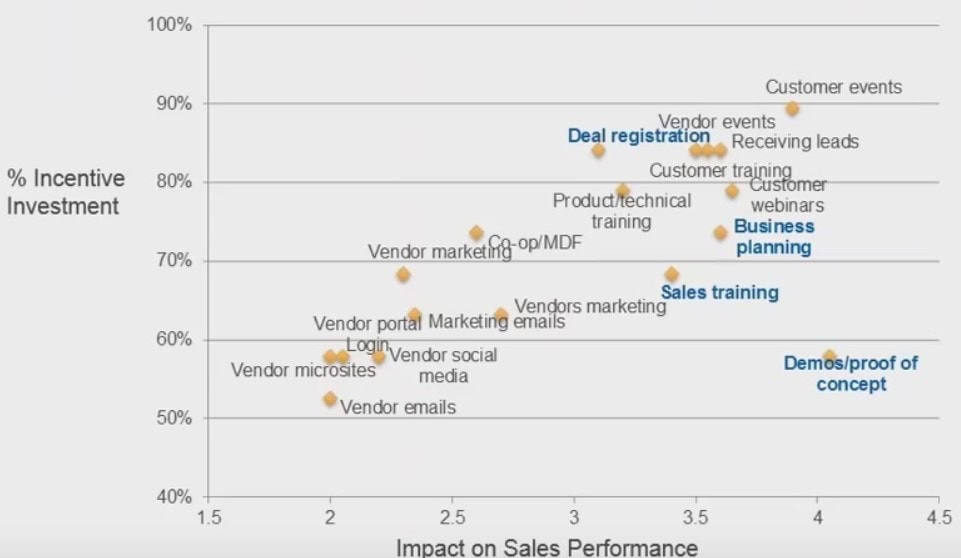Learn How High-Impact Channel Incentive Programs can lead to Mutual Vendor/Partner Success.
Selling products via partner ecosystems is no easy feat. That’s why building channel incentive programs are so important to channel vendors; it gives you the opportunity to demonstrate your unique value as a business partner.
However, due to its straightforwardness and familiarity, it comes as no surprise why selling “direct” has so much appeal to vendors.
According to a recent Gartner study, Channel partners usually fall into one of these three categories:
1.) Traditional – No infrastructure to collaborate in a centralized cloud-based environment
2.) Cloud-based – Partner has adopted a cloud-based infrastructure for exchanging data and collaborating with vendor
3.) Hybrid – Partner utilizes both “traditional” and “Cloud-based” processes
Given these differences, vendors frequently struggle to recruit, manage, train and sell to partners.
So, how do vendors transform these challenges and into money-making opportunities? What areas in the channel require the biggest investment that will enable partners to grow, sell and be successful? How do you better align your promotional strategies against your objectives? How do you influence the behavior of channel partners so that they are mutually beneficial?
Proper channel incentive programs mandate a . In order to improve the effectiveness of your indirect sales channels, regardless of the industry, your channel incentive programs and reimbursement opportunities require thorough management and mindful execution.
Here are 5 challenges vendors frequently struggle to solve while building channel incentive programs:
1.) Fighting For Partner MindShare
Vendors spew out faster by the day.
However, the constant and never-ending struggle to win and maintain partner mindshare continues to be a top challenge/goal for channel managers
2.) Realizing the right mix of incentives
Finding the incentive that will enable channel partners to perform at their best continues to be an ambiguous challenge
3.) Program ROI and Gaining Actionable Intelligence
“How do I know my programs are working?” is a question many channel managers struggle to answer.
4.) Program Spending
“How much should I be spending overall?” – In order to maximize partner effectiveness.
5.) Disengagement with Partner Portal
Partners are intimidated due to a plethora of options, logging in only for “as needed” basis
Building channel incentive programs that achieve maximum effectiveness
In order to avoid the previous challenges so often found in channel marketing, your channel incentive programs must be relevant to the strengths/weaknesses of each partner.
Too often, vendors implement (e.g., SPIFFs and rebates) in the hope that commission-like benefits will lead to more closed deals.
Although SPIFFs and rebates do gauge revenue, they should not be your only means of partner motivation.
Tiered pre-sales incentives—although time-consuming, more complex and difficult to execute, offer partners with constructive, tactical opportunities for achieving success. These incentives focus on improving partners’ go-to-market strategies that lead to long-term results, not short-term perks.
Here are some of the many examples associated with pre-sales incentives that:
- Providing partners with warm leads
- Social media training
- Co-branded digital marketing campaigns
- Event hosting for customers
- Joint business planning
- Demos/proof of concept
The survey-graph below illustrates how vendors view pre-sales incentive “investments” with overall “impact on sales performance.”

The answer: Three.
That’s right.
Three programs are all it takes to “package” these activities into revenue-driving vehicles (see graph below for pre/post-sale activities).

That’s how you differentiate your business from the competition; by investing in targeted, higher-impact incentive strategies during your channel incentive program creation, you have a greater opportunity to accelerate revenue at reduced costs.
How do you strategize pre-sales enablement incentives and post-sales promotions for each channel segment? This illustration gives you a good idea of which “baskets” you should put your “eggs.”

Building Channel Incentive Programs- Creating an Even More Appealing Program
In order to sustain that “competitive edge” over other businesses, you can implement several into your program.
Here are six examples:
- Offer Coop/MDF for a wider range of activities
- Reward partners for adopting behaviors which lead to sales aligned with your business plan
- Enable partners to combine or “stack” incentives and maximize their profits
- Reward partners for the penetration of new market(s) or sales of specific products
- Acquisition of market share
- Adapting your business model
You can begin to engage better with channel partners by being more creative with the types of programs (and the activities within those programs) you offer; accelerating revenue starts with your ability to demonstrates value. Therefore, incentive programs are your best ticket to sustain long-term, joint-partner success.
3 Mistakes to Avoid When Implementing Incentive Program for Channel Partners
Targeting the Wrong Target
Depending on the situation, the ‘demand chain’ can evolve into a multifaceted sales funnel where many players are actively involved. Because of this, business rapports develop obscurity to them, resulting in an incentive program incentivized to the wrong target. Whether it’s the end-user, reseller or distributor, vendors commonly offer sexy rewards to the wrong demographic.
Making the Process More Confusing than Need Be
As if channel marketing wasn’t confusing enough, vendors often provide incentive program with ambiguous guidelines and broadly worded, open to interpretation, terms, and conditions—an unnecessary, and entirely avoidable issue many vendors fail to resolve.
Traditional Methods, Harmful Results
Excel spreadsheets, emails, phone calls, and “chicken-scratched” transcripts have been the normality of managing marketing incentive program for decades. And because of this dated managerial process, vendors have lost an unprecedented amount of profit and channel partners due to erroneously submitted claims, long rebate delays, inaccurate accrual calculations, and misplaced channel data.